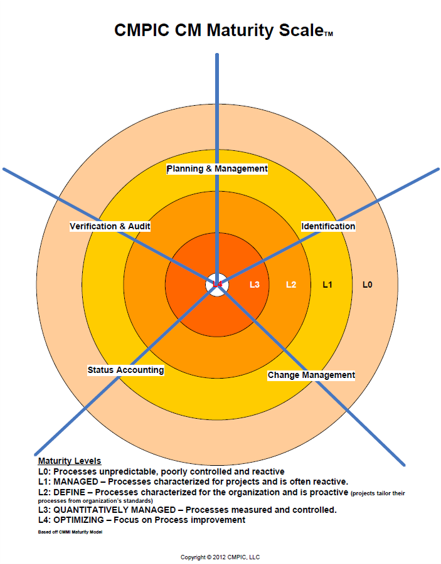Conducting a Configuration Management Assessment
This month’s CMsights looks at the why, what, who, and how of conducting a Configuration Management Assessment (CMA).
But first, what exactly is a Configuration Management Assessment and why should program, product, or project managers, who are not CM experts nor do they want to become one, care?
A Configuration Management Assessment typically provides a fact-finding review and independent analysis of current CM-related processes, plans, performance gaps, best practices support, personnel competencies, standards adherence, and deployed software capabilities. A comprehensive CMA will also identify and prioritize prospective improvements to any elements found deficient. Depending on the particular objectives, schedule, budget, and expected uses of the results, the scope of a CMA can include all of the aforementioned elements or only a few.
The highest-performing organizations recognize that configuration management and change control are not functions that should be buried deep inside a product engineering organization and left hidden from view until there is a product failure or public-relations disaster.
Example CM Maturity Scale Model from CMPIC
Instead, process-mature companies treat CM as an enterprise quality management imperative that deserves the support, funding, and oversight of managers and executives throughout the company as well as its supply chain. This includes consideration of each of the five fundamental functions of CM, as referenced in the CMPIC CM Maturity Scale model, and their associated digital threads that weave through numerous organizations outside of engineering.
Accordingly, the participating stakeholders in a CMA should include not only those in design and engineering but also in program/product management, contracts, manufacturing, test, quality, compliance, procurement, logistics, tech pubs, customer service and maintenance. The reason for all those participating is that inefficiencies, errors, and deficiencies in any one of these organizations or their processes can be the weakest link that precipitates a failure in performing CM.
Yet, how do managers within these functions – most who will not be very CM knowledgeable – assess whether their projects, products, processes, and people are aligned with relevant industry standards and best practices for CM? How can they measure the exposure or risk (i.e., technical, financial, regulatory, legal, and good will reputation) their organizations may have for underperforming in CM? And is it a best practice that an independent external CM consultancy, like CMstat, perform the assessment to avoid biases and faulty predispositions?
These questions can best be answered by conducting a CMA that leads to development of concrete actions that can become part of a new or updated Configuration Management system for a company.
Our CMsights video post for this month is from Lisa Fenwick, Vice President of CMstat and a CMPIC Certified CM Assessor Trainer, who provides a managerial-level summary of:
Why is CMA needed?
What constitutes a CMA?
Who should perform it?
Are there relevant standards?
What are potential missteps?
How to get started?
Now watch the 10-minute overview presentation below or directly on YouTube.
Learn more about CMAs and other useful resources in this article on Configuration Management Assessments which includes a checklist.
For a no-cost consultation to assess if your product, project, or organization can benefit from a CMA, contact the configuration management consultants at CMstat with an email to information@cmstat.com.
To receive future news and posts about CM, subscribe to CMsights HERE then follow CMstat on LinkedIn.
Receive CMsights
Subscribe to CMsights News for the latest updates from CMstat on Configuration Management, Data Management, EPOCH CM, and EPOCH DM.
Request a Demo
See how EPOCH CM and EPOCH DM support industry standards and best practices in Configuration Management and Data Management.


